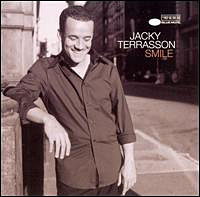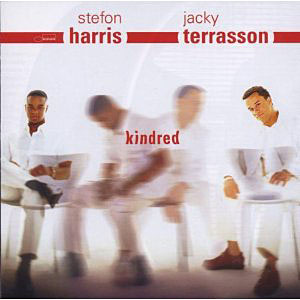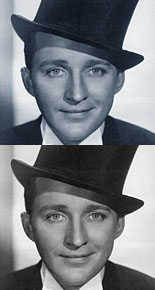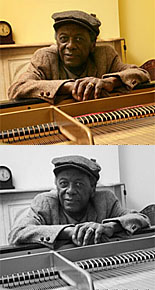Home » Jazz Articles » Old, New, Borrowed and Blue » Taken with Terrasson
Taken with Terrasson

When the festival dates were announced, I bought my tickets early, mapped out my club-hopping plan for each night, coordinated all of the logistics surrounding the weekend, and eagerly waited for January 7, 2011 to arrive. Unfortunately, all did not go as planned. By the time that day arrived, I was suffering from a cold and the worst cough I'd had since I was a child, and an ill-timed snow storm—seemingly localized over my exact travel route from Eastern Long Island into New York City—arrived at the same time as rush hour, making travel by car a very poor idea. Therefore, instead of soaking in the sounds of Anat Cohen's group, absorbing JD Allen's performance under the baton of Butch Morris, and reveling in the musical wonders brought forth by Aaron Goldberg's trio, I was asleep on my couch by 8:30.
When I awoke the next morning, I wasn't feeling much better, but sleep and cough medicine helped. I knew I'd be able to make it to some of the earlier performances in the evening, so my wife and I made our way to Manhattan, picked up our tickets and hurried over to Zinc Bar to catch pianist Jacky Terrasson with his trio.
Terrasson and his trio mates—bassist Ben Williams and drummer Jamire Williams—covered more ground during their all-too-short, forty-minute set than many of his contemporaries could cover in four hours, and those in attendance witnessed something truly special. Terrasson literally tugged away at the piano strings, blended Michael Jackson's "Beat It" and an abstracted take on "Body And Soul" with the more melodious strain of "Smoke Gets In Your Eyes," and touched on churchy, gospel-infused melodies with the help of Williams' bass. While that would have been enough to satiate my appetite, Terrasson also delivered his signature arrangement of Charlie Chaplin's "Smile," which proved to be the high point of the set.
 Hearing this piece couldn't help but take me back to my first encounter with Terrasson's music. While the pianist gained instant jazz celebrity status for his win at the Thelonious Monk Piano Competition in 1993—and for his role as the pianist in Betty Carter's group—I was only 16 at the time, and I didn't encounter his revelatory music until I heard Smile (Blue Note, 2003), a full decade later. Since that initial encounter, I've had the opportunity to look back and explore his early recordings, with bassist Ugonna Okegwo and drummer Leon Parker; soak in the sounds of his collaborative projects with the likes of vocalist Cassandra Wilson and vibraphonist Stefon Harris; delight in his solo work on Mirror (Blue Note, 2007); and absorb the wonders of his latest group on Push (Blue Note, 2010). As I heard each one of Terrasson's albums, my appreciation for his artistry only deepened, but I still hold a special place for Smile, and my fond memories of discovering this album came flooding back at the Zinc bar on that cold Saturday evening. With all of this in mind, I dedicate this month's Old, New Borrowed and Blue to the music of Jacky Terrasson.
Hearing this piece couldn't help but take me back to my first encounter with Terrasson's music. While the pianist gained instant jazz celebrity status for his win at the Thelonious Monk Piano Competition in 1993—and for his role as the pianist in Betty Carter's group—I was only 16 at the time, and I didn't encounter his revelatory music until I heard Smile (Blue Note, 2003), a full decade later. Since that initial encounter, I've had the opportunity to look back and explore his early recordings, with bassist Ugonna Okegwo and drummer Leon Parker; soak in the sounds of his collaborative projects with the likes of vocalist Cassandra Wilson and vibraphonist Stefon Harris; delight in his solo work on Mirror (Blue Note, 2007); and absorb the wonders of his latest group on Push (Blue Note, 2010). As I heard each one of Terrasson's albums, my appreciation for his artistry only deepened, but I still hold a special place for Smile, and my fond memories of discovering this album came flooding back at the Zinc bar on that cold Saturday evening. With all of this in mind, I dedicate this month's Old, New Borrowed and Blue to the music of Jacky Terrasson. Old
While Terrasson calls New York his home these days, Paris will always seem to hold a special place in his heart. Terrasson dedicated an entire album—the underappreciated A Paris... (Blue Note, 2000)—to the "City of Lights," but his first nod to La Ville-Lumière came with the first notes of his debut album.
Jacky Terrasson (Blue Note, 1995) announced the pianist's arrival as a first-rate recording artist, and he ushered in the proceedings with Cole Porter's "I Love Paris." Drummer Leon Parker was heard first, with his steady groove, and Terrasson makes his arrival known with one dissonant chord. He goes on to mix exploratory lines with melodious strains, but things take an immediate turn to the romantic when Parker briefly drops out. Complete consonance wins out and, when the drummer returns, Terrasson launches into a solo that mixes earthy lines with exotic statements and stabbing chords, before immediately shifting again.
Next, he invades cocktail lounge piano territory, with help from Ugonna Okegwo's walking bass line, but then he inserts his own personality into this section of the piece. As the familiar melody returns, Terrasson takes a chordal travel over the piano and his melodic snippets are presented in the deepest recesses of the 88s, helping to heat things up. Parker ratchets up the intensity level before departing, giving way to more serene expressions, but he returns for the final trio conglomeration. In these seven-and -half-minutes, Terrasson goes on a journey through Paris that's unlike any other, and he still continues to display the virtues of this city through his playing to this day, while developing the incredible technical ideas that he first displayed on this album.
 New
NewWhile more than fifteen years have passed since Terrasson's first album hit the shelves, his recordings continue to highlight his multifaceted talents and interests. Push arrived in a year when plenty of piano discs, from the likes of Vijay Iyer, Jason Moran, and several others, were getting loads of press, but Terrasson still managed to stand out in certain ways. From the opening notes of his "Gaux Girl"—which comes on as if it were equal parts Vince Guaraldi-like Charlie Brown music and spirited, New Orleans gospel fare—to the album closing "O Cafe, O Soleil," which benefits from Terrasson's vocals, he uses his expansive vocabulary to cover tremendous ground.
His medley of "Beat It" and "Body and Soul" is a shocking juxtaposition of dissimilar material that meets on ever-shifting land, foreign to both parties. Monk's "Ruby My Dear" takes on a breezy, Parisian air, thanks to the harmonica work of Gregoire Maret, while the other Monk inclusion, "'Round Midnight," features some down-and-out, bluesy licks from Terrasson and some extremely supportive and interactive bass work from Ben Williams. The trio even adds a seductive, dance-like feel toward the back end of the latter song.
Jacques Schwarz-Bart joins the group and heats things up on "Morning," but the trio needs no help as it makes fire on its own during the feisty "Beat Bop." As on his debut album, Terrasson can't resist throwing in a dash of Cole Porter, adding "You'd Be So Nice to Come Home To" into the program, and his softer side comes to the fore on the gentle journey through "My Church." Ben Williams delivers a spiritual solo here that perfectly captures the mood set forth earlier in the track, while Jamire Williams and Terrason provide understated accompaniment for this rising star bassist. This album, like every recording Terrasson has made, is chock full of musical information, but it's all delivered with alarming confidence, clarity and assurance, making it another fine addition to Terrasson's slowly expanding discography.
 Borrowed
BorrowedTerrasson's fondness for Cole Porter's music isn't an oddity in the world of jazz, but every time he borrows one of Porter's pieces, he manages to do miraculous things with the material at hand. In addition to the pieces already mentioned, Terrasson explores "Love For Sale" on Alive (Blue Note, 1998) and Lover Man (Venus Jazz, 2002), visits "What Is This Thing Called Love?" with Stefon Harris on Kindred, and works through "Just One Of Those Things" on Reach (Blue Note, 1996). The penultimate performance on this list proved to be just one of many exciting tracks born of the collaboration between two of the brightest lights in jazz today.
Harris and Terrasson's collaborative recording probably wouldn't exist if not for the telepathic connection that these two men shared during a stint at the Village Vanguard in the fall of 1999. Their onstage chemistry created sparks, and their intuitive relationship continued to evolve on Kindred (Blue Note, 2001). While the majority of the material on the record is performed by a quartet, Harris and Terrasson go it alone on Porter's "What Is This Thing Called Love?," which begins with broken phrases traded back and forth between them. The piece occasionally gains more traction, but the essence of the performance seems to reside in the choppy lines and quick reflexes that both men use. By the end of track, these two young lions of yesteryear are both gliding over the terrain with spirit and zest, but they pull back a little, with more playful exchanges, just as they near the finish line. While this is one of the shortest performances on the disc, it still remains one of many highlights on this superb outing.
Blue
Terrasson has often been lauded for his terrifying technique, but some of his most memorable and musical performances only use technique as a means to an end. One such piece—and one of my top five Terrasson tracks—is his take on Bill Lee's "Mo' Better Blues," originally from the Spike Lee film of the same name.
Drummer Eric Harland is instantly in the pocket, with his rim clicks, and Terrasson delivers a relaxed take on the melody before easing into his solo. Thematic development plays a big part in this performance and something as simple as two quickly passing call-and-response licks between Harland and Terrasson adds volumes to this brief track. While other performances on this album move at the speed of light and contain endless amounts of notes, Terrasson's economy on the piano is a brilliant demonstration of less is more and quality over quantity playing.
Even though the 2011 edition of Winter Jazzfest marked only my second live encounter with Terrasson, it surely won't be my last. Stay tuned for more Old, New, Borrowed and Blue.
Photo Credit
Daniel Sheehan
< Previous
Bailador
Next >
Pure Desmond
Comments
Tags
Jacky Terrasson
Old, New, Borrowed and Blue
Dan Bilawsky
United States
Anat Cohen
J.D. Allen
Aaron Goldberg
Ben Williams
Jamire Williams
Michael Jackson
Thelonious Monk
Betty Carter
Ugonna Okegwo
Leon Parker
Cassandra Wilson
Stefon Harris
Cole Porter
Vijay Iyer
jason moran
Vince Guaraldi
Gregoire Maret
Jacques Schwarz-Bart
Eric Harland
Concerts
For the Love of Jazz
 All About Jazz has been a pillar of jazz since 1995, championing it as an art form and, more importantly, supporting the musicians who create it. Our enduring commitment has made "AAJ" one of the most culturally important websites of its kind, read by hundreds of thousands of fans, musicians and industry figures every month.
All About Jazz has been a pillar of jazz since 1995, championing it as an art form and, more importantly, supporting the musicians who create it. Our enduring commitment has made "AAJ" one of the most culturally important websites of its kind, read by hundreds of thousands of fans, musicians and industry figures every month.





















